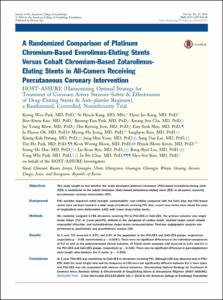KUMEL Repository
1. Journal Papers (연구논문)
1. School of Medicine (의과대학)
Dept. of Internal Medicine (내과학)
A Randomized Comparison of Platinum Chromium-Based Everolimus-Eluting Stents Versus Cobalt Chromium-Based Zotarolimus-Eluting Stents in All-Comers Receiving Percutaneous Coronary Intervention: HOST–ASSURE (Harmonizing Optimal Strategy for Treatment of Coronary Artery Stenosis–Safety & Effectiveness of Drug-Eluting Stents & Anti-platelet Regimen), a Randomized, Controlled, Noninferiority Trial
- Keimyung Author(s)
- Hur, Seung Ho
- Department
- Dept. of Internal Medicine (내과학)
- Journal Title
- Journal of the American College of Cardiology
- Issued Date
- 2014
- Volume
- 63
- Issue
- 25
- Keyword
- all-comers trial; clinical outcome; drug-eluting stent(s); percutaneous coronary intervention
- Abstract
- Objectives This study sought to test whether the newly developed platinum chromium (PtCr)-based everolimus-eluting stent
(EES) is noninferior to the cobalt chromium (CoCr)-based zotarolimus-eluting stent (ZES) in all-comers receiving
percutaneous coronary intervention (PCI).
Background PtCr provides improved radial strength, conformability, and visibility compared with the CoCr alloy, but PtCr-based
stents have not been tested in a wide range of patients receiving PCI. Also, recent case series have raised the issue
of longitudinal stent deformation (LSD) with newer drug-eluting stents.
Methods We randomly assigned 3,755 all-comers receiving PCI to PtCr-EES or CoCr-ZES. The primary outcome was target
lesion failure (TLF) at 1-year post-PCI, defined as the composite of cardiac death, nonfatal target vessel–related
myocardial infarction, and ischemia-driven target lesion revascularization. Post-hoc angiographic analysis was
performed to qualitatively and quantitatively analyze LSD.
Results At 1 year, TLF occurred in 2.9% and 2.9% of the population in the PtCr-EES and CoCr-ZES groups, respectively
(superiority p ¼ 0.98, noninferiority p ¼ 0.0247). There were no significant differences in the individual components
of TLF as well as the patient-oriented clinical outcome. Of 5,010 stents analyzed, LSD occurred in 0.2% and 0% in
the PtCr-EES and CoCr-ZES groups, respectively (p ¼ 0.104). There was no significant difference in post-deployment
stent length ratio between the 2 stents (p ¼ 0.352).
Conclusions At 1 year, PtCr-EES was noninferior to CoCr-ZES in all-comers receiving PCI. Although LSD was observed only in PtCr-
EES, both the stent length ratio and the frequency of LSD were not significantly different between the 2 stent types,
and PtCr-EES was not associated with adverse clinical outcomes. (Harmonizing Optimal Strategy for Treatment of
Coronary Artery Stenosis–SAfety & EffectiveneSS of Drug-ElUting Stents & Anti-platelet REgimen .
- Keimyung Author(s)(Kor)
- 허승호
- Publisher
- School of Medicine
- Citation
- Kyung Woo Park et al. (2014). A Randomized Comparison of Platinum Chromium-Based Everolimus-Eluting Stents Versus Cobalt Chromium-Based Zotarolimus-Eluting Stents in All-Comers Receiving Percutaneous Coronary Intervention: HOST–ASSURE (Harmonizing Optimal Strategy for Treatment of Coronary Artery Stenosis–Safety & Effectiveness of Drug-Eluting Stents & Anti-platelet Regimen), a Randomized, Controlled, Noninferiority Trial. Journal of the American College of Cardiology, 63(25), 2805–2816. doi: 10.1016/j.jacc.2014.04.013
- Type
- Article
- ISSN
- 0735-1097
- Appears in Collections:
- 1. School of Medicine (의과대학) > Dept. of Internal Medicine (내과학)
- 파일 목록
-
-
Download
 oak-aaa-2311.pdf
기타 데이터 / 981.3 kB / Adobe PDF
oak-aaa-2311.pdf
기타 데이터 / 981.3 kB / Adobe PDF
-
Items in Repository are protected by copyright, with all rights reserved, unless otherwise indicated.